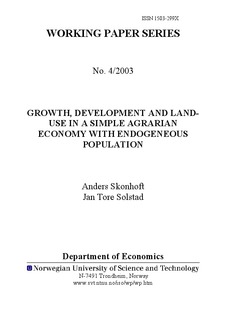| dc.contributor.author | Skonhoft, Anders | nb_NO |
| dc.contributor.author | Solstad, Jan Tore | nb_NO |
| dc.date.accessioned | 2014-12-19T14:31:55Z | |
| dc.date.available | 2014-12-19T14:31:55Z | |
| dc.date.created | 2006-10-05 | nb_NO |
| dc.date.issued | 2003 | nb_NO |
| dc.identifier | 126109 | nb_NO |
| dc.identifier.uri | http://hdl.handle.net/11250/267149 | |
| dc.description.abstract | The paper analyses the relation between demographic transformation, agricultural transformation and land-use pressure within a simple agrarian economy where population is treated both as a cause and consequence of economic changes. In this Malthusian-type of economy, population growth and food production are interrelated through two production activities. First, agricultural land and labour are tied up in production of agricultural products determining the current flow of consumption. Secondly, labour is used for converting the natural resource base in the form of wilderness, land into agricultural land. It is demonstrated that the economy can run into a poverty trap equilibrium which is the typical Malthusian situation. Alternatively, the equilibrium can be of a high income per capita type. Increasing returns to scale in food production together with an increasing amount of agricultural land, are the crucial factors behind this outcome. As increasing return to scale can be interpreted as if induced innovations take place, and can be seen in light of the presence of Boserup growth mechanisms. | nb_NO |
| dc.language | eng | nb_NO |
| dc.publisher | Institutt for samfunnsøkonomi | nb_NO |
| dc.relation.ispartofseries | Working Paper Series, 1503-299X; 2003:4 | nb_NO |
| dc.title | Growth, Development and Land-Use in a Simple Agrarian Economy with Endogeneous Population | nb_NO |
| dc.type | Research report | nb_NO |
| dc.contributor.department | Norges teknisk-naturvitenskapelige universitet, Fakultet for samfunnsvitenskap og teknologiledelse, Institutt for samfunnsøkonomi | nb_NO |
